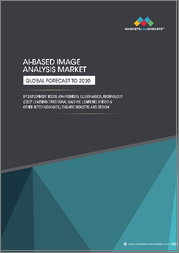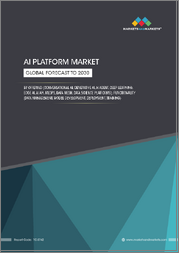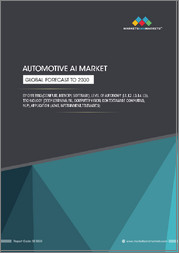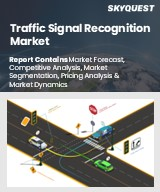
|
시장보고서
상품코드
1589330
세계의 딥러닝 칩셋 시장 : 유형별, 최종 사용자별 예측(2025-2030년)Deep Learning Chipset Market by Type (Application Specific Integrated Circuits, Central Processing Units, Field Programmable Gate Arrays), End-User (Aerospace & Defense, Automotive, Consumer Electronics) - Global Forecast 2025-2030 |
||||||
딥러닝 칩셋 시장의 2023년 시장 규모는 102억 3,000만 달러, 2024년에는 118억 2,000만 달러에 이를 것으로 예측되며, 복합 연간 성장률(CAGR) 15.69%로 성장하여, 2030년에는 283억 9,000만 달러에 달할 것으로 예상됩니다.
딥러닝 칩셋 시장은 인공지능과 하드웨어 엔지니어링의 역동적인 교차를 포함하여 컴퓨팅 효율, 속도 및 능력의 진보를 촉진합니다. 는 실시간 데이터 처리, 복잡한 문제 해결, 자동화를 가능하게 함으로써 자동차, 헬스케어, 금융, 가전 등 다양 업계의 용도에 힘을 쏟고 있습니다. 딥러닝 칩셋의 필요성은 의사 결정, 예측 분석 및 비즈니스 효율성을 높이는 AI 주도형 솔루션에 대한 수요가 증가함에 따라 강조되었습니다. 널리 자율 주행 시스템, 의료 영상 진단, 개별 금융 서비스, 스마트 장치 및 IoT 기술의 보급과 머신러닝 알고리즘 줌의 진보에 의해 강화되고 있습니다. 주요 성장 요인의 조사로부터, 최종 사용자 산업에 있어서의 AI 도입 증가, AI 연구 개발에 대한 투자의 확대, 스마트 인프라의 대두가 극히 중요한 영향을 미치고 있는 것이 새로운 비즈니스 기회는 에너지 효율과 가속화를 위한 칩 아키텍처의 최적화와 처리 능력의 획기적인 향상을 약속합니다. 딥러닝과 양자 컴퓨팅 간의 상호 작용이 확대되고 있습니다. 또한 데이터의 프라이버시와 보안에 대한 우려가 있으며 시장의 신뢰성에 영향을 줄 수 있습니다.기술 혁신의 중요한 영역으로는 특정 AI 용도을 위한 칩 설계 개선, 신경망의 교육 효과 향상, 틈새 시장과 차별화 가능성을 제공하는 에지 디바이스에 딥러닝 기능 통합 등 포함됩니다. 사업 성장을 위해, 기업은 협업 파트너십을 활용한 민첩한 전략에 주력하여 최첨단 칩 설계와 AI 전개를 위한 스킬 개발에 투자해야 합니다. 한계와 증가하는 요구를 모두 충족하는 선구적인 솔루션 기계가 익습니다.
| 주요 시장 통계 | |
|---|---|
| 기준년(2023) | 102억 3,000만 달러 |
| 예측년(2024) | 118억 2,000만 달러 |
| 예측년(2030) | 283억 9,000만 달러 |
| 복합 연간 성장률(CAGR)(%) | 15.69% |
시장 역학 : 빠르게 진화하는 딥러닝 칩셋 시장의 주요 시장 인사이트 공개
딥러닝 칩셋 시장은 수요 및 공급의 역동적인 상호작용에 의해 변모를 이루고 있습니다. 정교화 및 새로운 비즈니스 기회 획득에 대비 이러한 동향을 종합적으로 파악함으로써 기업은 정치적, 지리적, 기술적, 사회적, 경제적 영역에 걸친 다양한 위험을 완화할 수 있으며, 소비 자 행동과 그것이 제조 비용과 구매 동향에 미치는 영향을 더욱 명확하게 이해할 수 있습니다.
- 시장 성장 촉진요인
- 클라우드 기반 기술의 수용 확대
- 업계 전체의 빅데이터 분석 적용 확대
- 양자 컴퓨팅의 대두와 로봇 공학에 있어서의 딥러닝 칩의 실장 강화
- 시장 성장 억제요인
- 숙련된 전문지식과 훈련을 받은 전문가의 부족
- 시장 기회
- 인간을 의식한 AI 시스템 개발의 지속적인 요구
- 자율형 로봇 개발
- 시장의 과제
- 투자 수익률 저하와 이용 가능한 구조 데이터의 제한
Porter's Five Forces : 딥러닝 칩셋 시장을 탐색하는 전략 도구
Porter's Five Forces Framework는 시장 상황경쟁 구도를 이해하는 중요한 도구입니다. Porter's Five Forces Framework는 기업의 경쟁을 평가하고 전략적 기회를 탐구하는 명확한 기술을 설명합니다. 이 프레임워크는 기업이 시장 내 세력도를 평가하고 신규 사업의 수익성을 결정하는 데 도움이 됩니다. 당신은 더 강인한 시장에서 포지셔닝을 보장할 수 있습니다.
PESTLE 분석 : 딥러닝 칩셋 시장에서 외부 영향을 파악
외부 거시 환경 요인은 딥러닝 칩셋 시장의 성과 역학을 형성하는 데 매우 중요한 역할을 합니다.의 영향을 탐색하는 데 필요한 정보 제공합니다.PESTLE 요인을 조사함으로써 기업은 잠재적인 위험과 기회를 더 잘 이해할 수 있습니다. 앞을 내다보고 적극적인 의사 결정을 할 준비가되어 있습니다.
시장 점유율 분석 딥러닝 칩셋 시장 경쟁 구도 파악
딥러닝 칩셋 시장의 상세한 시장 점유율 분석을 통해 공급업체의 성과를 종합적으로 평가할 수 있습니다. 기업은 수익, 고객 기반, 성장률 등 주요 지표를 비교하여 경쟁 포지셔닝을 밝힐 수 있습니다. 이 분석을 통해 시장 집중, 단편화, 통합 동향을 밝혀내고 벤더들은 경쟁이 치열해지는 가운데 자사의 지위를 높이는 전략적 의사 결정을 내리는 데 필요한 지식을 얻을 수 있습니다.
FPNV 포지셔닝 매트릭스 딥러닝 칩셋 시장에서 공급업체의 성능 평가
FPNV 포지셔닝 매트릭스는 딥러닝 칩셋 시장에서 공급업체를 평가하는 중요한 도구입니다. 이 행렬을 통해 비즈니스 조직은 공급업체의 비즈니스 전략과 제품 만족도를 기준으로 평가하여 목표에 맞는 충분한 정보를 바탕으로 의사 결정을 내릴 수 있습니다. 네 가지 사분면을 통해 공급업체를 명확하고 정확하게 세분화하여 전략 목표에 가장 적합한 파트너 및 솔루션을 파악할 수 있습니다.
전략 분석 및 권장 딥러닝 칩셋 시장에서 성공에 대한 길을 그립니다.
딥러닝 칩셋 시장의 전략 분석은 시장에서의 프레즌스 강화를 목표로 하는 기업에 필수적입니다. 주요 자원, 역량 및 성과 지표를 검토함으로써 기업은 성장 기회를 파악하고 개선을 위해 노력할 수 있습니다. 이 접근법을 통해 경쟁 구도에서 과제를 극복하고 새로운 비즈니스 기회를 활용하여 장기적인 성공을 거둘 수 있는 체제를 구축할 수 있습니다.
이 보고서는 주요 관심 분야를 포괄하는 시장의 종합적인 분석을 제공합니다.
1. 시장 침투 : 현재 시장 환경의 상세한 검토, 주요 기업의 광범위한 데이터, 시장 도달범위 및 전반적인 영향력 평가.
2. 시장 개척도 : 신흥 시장의 성장 기회를 파악하고 기존 분야의 확장 가능성을 평가하며 미래 성장을 위한 전략적 로드맵을 제공합니다.
3. 시장 다양화 : 최근 제품 출시, 미개척 지역, 업계의 주요 진보, 시장을 형성하는 전략적 투자를 분석합니다.
4. 경쟁 평가 및 정보 : 경쟁 구도를 철저히 분석하여 시장 점유율, 사업 전략, 제품 포트폴리오, 인증, 규제 당국 승인, 특허 동향, 주요 기업의 기술 진보 등을 검증합니다.
5. 제품 개발 및 혁신 : 미래 시장 성장을 가속할 것으로 예상되는 최첨단 기술, R&D 활동, 제품 혁신을 강조합니다.
또한 이해관계자가 충분한 정보를 얻고 의사결정을 할 수 있도록 중요한 질문에 대답하고 있습니다.
1. 현재 시장 규모와 향후 성장 예측은?
2. 최고의 투자 기회를 제공하는 제품, 부문 및 지역은 어디입니까?
3. 시장을 형성하는 주요 기술 동향과 규제의 영향은?
4. 주요 벤더의 시장 점유율과 경쟁 포지션은?
5. 벤더 시장 진입, 철수 전략의 원동력이 되는 수익원과 전략적 기회는 무엇인가?
목차
제1장 서문
제2장 조사 방법
제3장 주요 요약
제4장 시장 개요
제5장 시장 인사이트
- 시장 역학
- 성장 촉진요인
- 클라우드 기반 기술의 보급
- 업계 전체에서의 빅데이터 분석의 응용이 증가
- 양자 컴퓨팅의 대두와 로봇 공학에 있어서의 딥러닝 칩의 실장 강화
- 억제요인
- 숙련된 전문지식과 훈련을 받은 전문가의 부족
- 기회
- 인간을 인식하는 AI 시스템 개발의 필요성이 계속
- 자율형 로봇의 새로운 개발
- 과제
- 투자 수익률 저하와 이용 가능한 구조 데이터의 제한
- 성장 촉진요인
- 시장 세분화 분석
- Porter's Five Forces 분석
- PESTEL 분석
- 정치적
- 경제
- 사교
- 기술적
- 법률상
- 환경
제6장 딥러닝 칩셋 시장 : 유형별
- 특정 용도용 집적 회로
- 중앙처리장치
- 필드 프로그래머블 게이트 어레이
- 그래픽 프로세싱 유닛
제7장 딥러닝 칩셋 시장 : 최종 사용자별
- 항공우주 및 방어
- 자동차
- 가전
- 헬스케어
- 산업
제8장 아메리카의 딥러닝 칩셋 시장
- 아르헨티나
- 브라질
- 캐나다
- 멕시코
- 미국
제9장 아시아태평양의 딥러닝 칩셋 시장
- 호주
- 중국
- 인도
- 인도네시아
- 일본
- 말레이시아
- 필리핀
- 싱가포르
- 한국
- 대만
- 태국
- 베트남
제10장 유럽, 중동 및 아프리카의 딥러닝 칩셋 시장
- 덴마크
- 이집트
- 핀란드
- 프랑스
- 독일
- 이스라엘
- 이탈리아
- 네덜란드
- 나이지리아
- 노르웨이
- 폴란드
- 카타르
- 러시아
- 사우디아라비아
- 남아프리카
- 스페인
- 스웨덴
- 스위스
- 터키
- 아랍에미리트(UAE)
- 영국
제11장 경쟁 구도
- 시장 점유율 분석(2023년)
- FPNV 포지셔닝 매트릭스(2023년)
- 경쟁 시나리오 분석
- 전략 분석과 제안
기업 목록
- Advanced Micro Devices, Inc.
- ARM Holdings
- Google LLC
- Graphcore
- Huawei Technologies
- Intel Corporation
- International Business Machines Corporation
- LG Electronics
- Mythic AI
- NVIDIA Corporation
- Qualcomm Technologies, Inc.
- Samsung Electronics Co. Ltd.
- Taiwan Semiconductor Manufacturing Company
- Xilinx, Inc.
- Zero ASIC Corporation
The Deep Learning Chipset Market was valued at USD 10.23 billion in 2023, expected to reach USD 11.82 billion in 2024, and is projected to grow at a CAGR of 15.69%, to USD 28.39 billion by 2030.
The deep learning chipset market encompasses a dynamic intersection of artificial intelligence and hardware engineering, driving advancements in computational efficiency, speed, and capability. These chipsets, including GPUs, TPUs, neuromorphic chips, and FPGAs, power applications across diverse industries like automotive, healthcare, finance, and consumer electronics by enabling real-time data processing, complex problem solving, and automation. The necessity for deep learning chipsets is underscored by the escalating demand for AI-driven solutions that enhance decision-making, predictive analytics, and operational efficiency. End-use scope is broad, spanning autonomous driving systems, medical imaging diagnostics, personalized finance services, and smart devices, bolstered by the proliferation of IoT technologies and advancements in machine learning algorithms. Insights into key growth factors reveal that the increasing adoption of AI in end-user industries, growing investments in AI research and development, and the rise of smart infrastructures are pivotal influences. Emerging opportunities lie in the optimization of chip architectures for energy efficiency and speed, as well as the growing intersections between deep learning and quantum computing, which promise exponential improvements in processing power. However, the market faces challenges, including high development costs, technical complexities, and the need for a scalable infrastructure to support advanced AI workloads. Additionally, there are concerns over data privacy and security, which may impact market confidence. Critical areas of innovation include improving chip design for specific AI applications, enhancing neural network training efficacy, and embedding deep learning capabilities into edge devices, offering potential for niche markets and differentiation. For business growth, companies should focus on agile strategies that leverage collaborative partnerships and invest in skill development for cutting-edge chip design and AI deployment. The market's nature is competitive yet full of promise, with a landscape ripe for pioneering solutions that address both the technical limitations and growing demands of the AI revolution.
| KEY MARKET STATISTICS | |
|---|---|
| Base Year [2023] | USD 10.23 billion |
| Estimated Year [2024] | USD 11.82 billion |
| Forecast Year [2030] | USD 28.39 billion |
| CAGR (%) | 15.69% |
Market Dynamics: Unveiling Key Market Insights in the Rapidly Evolving Deep Learning Chipset Market
The Deep Learning Chipset Market is undergoing transformative changes driven by a dynamic interplay of supply and demand factors. Understanding these evolving market dynamics prepares business organizations to make informed investment decisions, refine strategic decisions, and seize new opportunities. By gaining a comprehensive view of these trends, business organizations can mitigate various risks across political, geographic, technical, social, and economic domains while also gaining a clearer understanding of consumer behavior and its impact on manufacturing costs and purchasing trends.
- Market Drivers
- Growing acceptance of cloud-based technology
- Increasing application of big data analytics across industries
- Rising quantum computing and enhanced implementation of deep learning chips in robotics
- Market Restraints
- Lack of skilled expertise and trained professional
- Market Opportunities
- Ongoing need to develop human-aware AI systems
- Emerging development of autonomous robots
- Market Challenges
- Reduced return on investment and limited structural data available
Porter's Five Forces: A Strategic Tool for Navigating the Deep Learning Chipset Market
Porter's five forces framework is a critical tool for understanding the competitive landscape of the Deep Learning Chipset Market. It offers business organizations with a clear methodology for evaluating their competitive positioning and exploring strategic opportunities. This framework helps businesses assess the power dynamics within the market and determine the profitability of new ventures. With these insights, business organizations can leverage their strengths, address weaknesses, and avoid potential challenges, ensuring a more resilient market positioning.
PESTLE Analysis: Navigating External Influences in the Deep Learning Chipset Market
External macro-environmental factors play a pivotal role in shaping the performance dynamics of the Deep Learning Chipset Market. Political, Economic, Social, Technological, Legal, and Environmental factors analysis provides the necessary information to navigate these influences. By examining PESTLE factors, businesses can better understand potential risks and opportunities. This analysis enables business organizations to anticipate changes in regulations, consumer preferences, and economic trends, ensuring they are prepared to make proactive, forward-thinking decisions.
Market Share Analysis: Understanding the Competitive Landscape in the Deep Learning Chipset Market
A detailed market share analysis in the Deep Learning Chipset Market provides a comprehensive assessment of vendors' performance. Companies can identify their competitive positioning by comparing key metrics, including revenue, customer base, and growth rates. This analysis highlights market concentration, fragmentation, and trends in consolidation, offering vendors the insights required to make strategic decisions that enhance their position in an increasingly competitive landscape.
FPNV Positioning Matrix: Evaluating Vendors' Performance in the Deep Learning Chipset Market
The Forefront, Pathfinder, Niche, Vital (FPNV) Positioning Matrix is a critical tool for evaluating vendors within the Deep Learning Chipset Market. This matrix enables business organizations to make well-informed decisions that align with their goals by assessing vendors based on their business strategy and product satisfaction. The four quadrants provide a clear and precise segmentation of vendors, helping users identify the right partners and solutions that best fit their strategic objectives.
Strategy Analysis & Recommendation: Charting a Path to Success in the Deep Learning Chipset Market
A strategic analysis of the Deep Learning Chipset Market is essential for businesses looking to strengthen their global market presence. By reviewing key resources, capabilities, and performance indicators, business organizations can identify growth opportunities and work toward improvement. This approach helps businesses navigate challenges in the competitive landscape and ensures they are well-positioned to capitalize on newer opportunities and drive long-term success.
Key Company Profiles
The report delves into recent significant developments in the Deep Learning Chipset Market, highlighting leading vendors and their innovative profiles. These include Advanced Micro Devices, Inc., ARM Holdings, Google LLC, Graphcore, Huawei Technologies, Intel Corporation, International Business Machines Corporation, LG Electronics, Mythic AI, NVIDIA Corporation, Qualcomm Technologies, Inc., Samsung Electronics Co., Ltd., Taiwan Semiconductor Manufacturing Company, Xilinx, Inc., and Zero ASIC Corporation.
Market Segmentation & Coverage
This research report categorizes the Deep Learning Chipset Market to forecast the revenues and analyze trends in each of the following sub-markets:
- Based on Type, market is studied across Application Specific Integrated Circuits, Central Processing Units, Field Programmable Gate Arrays, and Graphics Processing Units.
- Based on End-User, market is studied across Aerospace & Defense, Automotive, Consumer Electronics, Healthcare, and Industrial.
- Based on Region, market is studied across Americas, Asia-Pacific, and Europe, Middle East & Africa. The Americas is further studied across Argentina, Brazil, Canada, Mexico, and United States. The United States is further studied across California, Florida, Illinois, New York, Ohio, Pennsylvania, and Texas. The Asia-Pacific is further studied across Australia, China, India, Indonesia, Japan, Malaysia, Philippines, Singapore, South Korea, Taiwan, Thailand, and Vietnam. The Europe, Middle East & Africa is further studied across Denmark, Egypt, Finland, France, Germany, Israel, Italy, Netherlands, Nigeria, Norway, Poland, Qatar, Russia, Saudi Arabia, South Africa, Spain, Sweden, Switzerland, Turkey, United Arab Emirates, and United Kingdom.
The report offers a comprehensive analysis of the market, covering key focus areas:
1. Market Penetration: A detailed review of the current market environment, including extensive data from top industry players, evaluating their market reach and overall influence.
2. Market Development: Identifies growth opportunities in emerging markets and assesses expansion potential in established sectors, providing a strategic roadmap for future growth.
3. Market Diversification: Analyzes recent product launches, untapped geographic regions, major industry advancements, and strategic investments reshaping the market.
4. Competitive Assessment & Intelligence: Provides a thorough analysis of the competitive landscape, examining market share, business strategies, product portfolios, certifications, regulatory approvals, patent trends, and technological advancements of key players.
5. Product Development & Innovation: Highlights cutting-edge technologies, R&D activities, and product innovations expected to drive future market growth.
The report also answers critical questions to aid stakeholders in making informed decisions:
1. What is the current market size, and what is the forecasted growth?
2. Which products, segments, and regions offer the best investment opportunities?
3. What are the key technology trends and regulatory influences shaping the market?
4. How do leading vendors rank in terms of market share and competitive positioning?
5. What revenue sources and strategic opportunities drive vendors' market entry or exit strategies?
Table of Contents
1. Preface
- 1.1. Objectives of the Study
- 1.2. Market Segmentation & Coverage
- 1.3. Years Considered for the Study
- 1.4. Currency & Pricing
- 1.5. Language
- 1.6. Stakeholders
2. Research Methodology
- 2.1. Define: Research Objective
- 2.2. Determine: Research Design
- 2.3. Prepare: Research Instrument
- 2.4. Collect: Data Source
- 2.5. Analyze: Data Interpretation
- 2.6. Formulate: Data Verification
- 2.7. Publish: Research Report
- 2.8. Repeat: Report Update
3. Executive Summary
4. Market Overview
5. Market Insights
- 5.1. Market Dynamics
- 5.1.1. Drivers
- 5.1.1.1. Growing acceptance of cloud-based technology
- 5.1.1.2. Increasing application of big data analytics across industries
- 5.1.1.3. Rising quantum computing and enhanced implementation of deep learning chips in robotics
- 5.1.2. Restraints
- 5.1.2.1. Lack of skilled expertise and trained professional
- 5.1.3. Opportunities
- 5.1.3.1. Ongoing need to develop human-aware AI systems
- 5.1.3.2. Emerging development of autonomous robots
- 5.1.4. Challenges
- 5.1.4.1. Reduced return on investment and limited structural data available
- 5.1.1. Drivers
- 5.2. Market Segmentation Analysis
- 5.3. Porter's Five Forces Analysis
- 5.3.1. Threat of New Entrants
- 5.3.2. Threat of Substitutes
- 5.3.3. Bargaining Power of Customers
- 5.3.4. Bargaining Power of Suppliers
- 5.3.5. Industry Rivalry
- 5.4. PESTLE Analysis
- 5.4.1. Political
- 5.4.2. Economic
- 5.4.3. Social
- 5.4.4. Technological
- 5.4.5. Legal
- 5.4.6. Environmental
6. Deep Learning Chipset Market, by Type
- 6.1. Introduction
- 6.2. Application Specific Integrated Circuits
- 6.3. Central Processing Units
- 6.4. Field Programmable Gate Arrays
- 6.5. Graphics Processing Units
7. Deep Learning Chipset Market, by End-User
- 7.1. Introduction
- 7.2. Aerospace & Defense
- 7.3. Automotive
- 7.4. Consumer Electronics
- 7.5. Healthcare
- 7.6. Industrial
8. Americas Deep Learning Chipset Market
- 8.1. Introduction
- 8.2. Argentina
- 8.3. Brazil
- 8.4. Canada
- 8.5. Mexico
- 8.6. United States
9. Asia-Pacific Deep Learning Chipset Market
- 9.1. Introduction
- 9.2. Australia
- 9.3. China
- 9.4. India
- 9.5. Indonesia
- 9.6. Japan
- 9.7. Malaysia
- 9.8. Philippines
- 9.9. Singapore
- 9.10. South Korea
- 9.11. Taiwan
- 9.12. Thailand
- 9.13. Vietnam
10. Europe, Middle East & Africa Deep Learning Chipset Market
- 10.1. Introduction
- 10.2. Denmark
- 10.3. Egypt
- 10.4. Finland
- 10.5. France
- 10.6. Germany
- 10.7. Israel
- 10.8. Italy
- 10.9. Netherlands
- 10.10. Nigeria
- 10.11. Norway
- 10.12. Poland
- 10.13. Qatar
- 10.14. Russia
- 10.15. Saudi Arabia
- 10.16. South Africa
- 10.17. Spain
- 10.18. Sweden
- 10.19. Switzerland
- 10.20. Turkey
- 10.21. United Arab Emirates
- 10.22. United Kingdom
11. Competitive Landscape
- 11.1. Market Share Analysis, 2023
- 11.2. FPNV Positioning Matrix, 2023
- 11.3. Competitive Scenario Analysis
- 11.4. Strategy Analysis & Recommendation
Companies Mentioned
- 1. Advanced Micro Devices, Inc.
- 2. ARM Holdings
- 3. Google LLC
- 4. Graphcore
- 5. Huawei Technologies
- 6. Intel Corporation
- 7. International Business Machines Corporation
- 8. LG Electronics
- 9. Mythic AI
- 10. NVIDIA Corporation
- 11. Qualcomm Technologies, Inc.
- 12. Samsung Electronics Co., Ltd.
- 13. Taiwan Semiconductor Manufacturing Company
- 14. Xilinx, Inc.
- 15. Zero ASIC Corporation



















